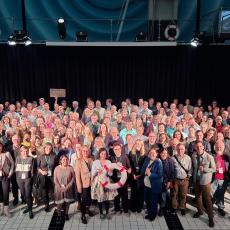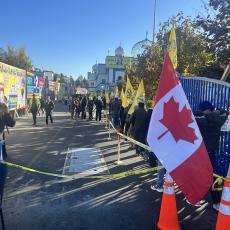The original draft of the "Magna Charta" for Democracy Cities was formulated in Rome in 2018. Since then, it has been the subject of extensive global discussion. Now, the initial document has been developed, revised and reorganized into a communication instrument. The document identifies 20 different dimensions for democratic progress on the local level— so that citizens and urban institutions can form an idea of where their own cities rank in terms of democracy development.
Here are the 20 democratic dimensions of the "Magna Charta":
- Democratisation as a permanent task: structural anchoring of permanent democratisation
Democracy cities are places where people never stop working to make their communities more democratic. Democracy cities are searchers. They experiment. They seek ways, new and old, proven and unproven, to deepen participation. Democracy cities are never satisfied with today’s democratic advances—because they are too busy working on tomorrow’s.
- Room for dialogue: Spaces and infrastructure for discussions and decisions by citizens
A democracy city seeks to create physical spaces where people can be with each other, discuss with each other, and make democratic decisions together, freely and safely. In democracy cities, these spaces may take any number of forms, from previously abandoned buildings, to libraries, to schools, to streets reclaimed from brutal traffic, to centers that are explicitly houses of democracy.
- Democracy as parity: no different standards for elected officials and citizens
A democracy city is a place where citizens can decide alongside politicians on any issue or question. Citizens and politicians are equals.
- Infrastructure of participation: Continuous development of the infrastructure for participation & democracy
A democracy city is always developing infrastructure—human, physical and digital—for participation and democracy. In addition, a democracy city is committed to the openness and transparency of this infrastructure—so that the infrastructure can itself be refined and altered by the people to better serve democracy and participation.
- Protection of local self-determination: definition of the rules for participation & democracy by the citizens
In a democracy city, the rules for participation and democracy are decided by the people themselves. A democracy city protects its democratic practices and procedures.
- A voice for young people: a genuine democratic voice for young people
A democracy city works not only to educate and train youth for democracy but also to give young people, even those not old enough in the vote, real democratic power, especially over the issues that affect them most.
- Social movements as engines of democracy: promoting exchanges between people and social movements
A democracy city is a place where people can connect with neighbours and strangers alike. Such a city promotes social movements that seek to protect and strengthen democracy.
- From the local to the national and transnational: having a say on higher political levels by way of the city
In a democracy city, citizens work together to participate not just at the neighbourhood and local levels but also to find ways to participate at the regional, national and transnational levels of democracy.
- Agenda 2030 in practice: sustainability
A democracy city supports sustainability through participatory instruments, because there’s no future democracy without sustainability.
- Participation as a process: encouraging and promoting participation in all stages of development
A democracy city encourages people to participate in decision-making in every step of developing policymaking—from proposals, to research, to debate, to the decisions in the end.
- Enforcement and transparency: Sufficient resources to implement citizens' decisions and monitor their implementation
A democracy city requires resources to implement what citizens have decided upon, and citizens need to be able to understand and control how those resources are spent.
- Elections made easy: simple voting
A democracy city allows voters to cast their ballots with ease, and there should be no discrimination about the technology used. Rather, a democracy city should support the integration of traditional voting and electronic voting in ways that are secure, build trust, and follow best international practices.
- Every resident is also a citizen: residual voting rights
Elections in a democracy city include all people, residents and stakeholders, including those who may be excluded from elections by the national government.
- Every vote is heard: every vote is also heard between election and voting days
Although ballot decisions are necessary, a democracy city and its people know that elections and votes alone are not enough. In a democracy city, every vote is counted on election day— and every voice is heard year-round.
- Democracy Support: Support for the development of ideas of the citizens
A democracy city doesn’t just permit citizens to offer their ideas for laws, constitutional amendments or regulations. A democracy city also welcomes suggestions, and supports its citizens in presenting their ideas in such a way that they are taken seriously by official politics.
- Modern direct democracy: Modern direct democracy and participatory procedures for the involvement of all stakeholders
In a democracy city, the citizens themselves can propose and enact laws (regulations) and constitutions (charters). This is done using the instruments of modern direct democracy such as initiative and referendum, and via tools of participatory democracy, like participatory budgeting. Democracy cities design these tools in ways that encourage participation by everyone.
- Open governance: Digital access to information (e-government, open data etc.)
A democracy city tries to make accessible all tools necessary for citizenship in reliable digital spaces.
- Representation of the under-represented: protection of minorities, equality
A democracy city protects the rights of minorities and seeks diverse representation and parity between genders, races, religions, ages and geographies, not just among elected political office holders or civil servants, but also in public participation.
- Media and public infrastructure: Media as help for citizens
A democracy city has diverse and reliable sources of news and context to help the people to govern themselves.
- City of the "happy losers": Addressing the concerns of the losing side
A democracy city is a place of "happy losers". That means that, after a decision is taken, the losing side in the debate feels like they were heard, and had a fair chance to participate.


